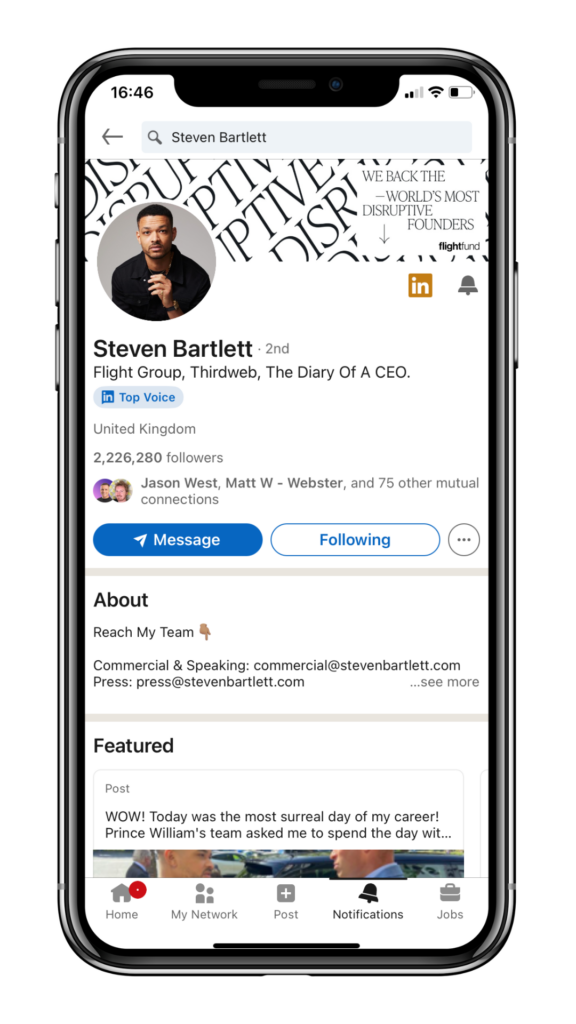In today’s digital age where even your next-door neighbour’s cat has its own TikTok account, the role of the C-Suite executive is evolving. No longer confined to the boardroom, today’s leaders are stepping into the social media spotlight, wielding the power of C-Suite personal branding to amplify their influence.
At Giraffe Social, we believe that C-suite personal branding on social media is not just a trend; it’s a strategic necessity. Executives who effectively leverage their online presence can build trust, foster deeper relationships, and enhance their company’s reputation.
In this post, we’ll explore the significance of personal branding for top executives and share insights on how to cultivate an authentic and engaging social media presence.
The human-first approach to C-Suite personal branding
Did you know that CEOs who are active on social media are seen as better leaders? By being transparent and accessible, it allows for better connections to be built between not only employees but customers as well. However, this is a paradigm shift from traditional corporate communication where the C-Suite would be seen as the figureheads of the company.
Authenticity is the cornerstone of a human-first approach. This involves focusing on showcasing a leader’s personality, beliefs and vision in a way that is not only authentic but resonates with the audience. Leaders who are genuine about their successes, challenges, and even failures typically win the trust of the audience easier than someone disingenuous. Hence, when the C-Suite share real stories, lessons learned, and personal insights it typically resonates more with their audience.
Steven Barlett, founder of Diary Of CEO, is a great example of an executive who often shares personal reflections and experiences on his social media platforms. His posts offer a window into his personal values while simultaneously sharing his professional insight and experience. Creating both emotional and intellectual value to his content, making him appear both relatable and trustworthy.

Establishing a thought-leadership platform
One of the biggest benefits of encouraging C-Suite executives to take to social media is the ability to establish thought leadership. When it comes to thought-leadership content, sharing trends, industry news, and forward-thinking strategies all make a good starting point. But, to really connect with their audience adding personality and personal perspective is essential to position and cement themselves as thought leaders.
How much difference can being a thought leader really make though? Well, when it comes to B2B sales, 92% of buyers are much more likely to engage with a sales professional that they see as a thought leader in their industry. Those C-Suite members who can effectively communicate their knowledge not only enhance their company’s reputation but also attracts top talent AND influences potential customers!
Driving corporate wellbeing & culture
It’s not just about external influence when it comes to the C-Suite engaging on social media, it can also have a significant impact on the internal culture of the brand. Platforms like LinkedIn can be used to communicate and embody the company’s values and culture. Using their platform to celebrate team successes, acknowledge individuals, and communicate strategic decisions, the C-Suite create transparency within their work. As a result, 70% of employees feel more connected to their CEO when the CEO is active on their own social platforms. This leads to higher morale and improved workplace culture. Good workplace culture typically makes a brand more desirable to employees, but can also make a brand more desirable to consumers.
Managing crisis and building resilience
In the modern age of digital witch hunts, consumers and internal stakeholders will often look to the C-Suite to provide reassurance and guidance. If an executive is already active and engaged on social media they are able to address issues head-on, communicate the steps being taken to diffuse the situation, and reassure stakeholders. Not only are they able to help manage the crisis, but can help to quickly aid with rapid recovery.
Implementing effective C-Suite personal branding
- Define objectives: Understand what is to be achieved from the personal brand. It is thought leadership, company culture enforcement, or crisis management?
- Select the right platform: We know that not every platform works for every brand, well this applies to personal branding as well. While traditional many C-Suite employees may opts for LinkedIn, but a Gen Z employee may opt for something more visual like Instagram or TikTok.
- Content planning: Now the thing with personal branding is your content doesn’t need to be planned…but it’ll probably perform better if you put some strategy into it. Share content that reflects brand values, industry insights, and personal perspectives. Ensure it aligns with the overall brand message of the company.
- Engagement: It’s not enough to just post and ghost. Interaction is the key to mastering a personal brand. Commenting, liking and sharing showcases that there is a person behind the brand, ensuring authenticity.
- Monitor & adapt: As with any social media strategy, you’re not going to nail it the first time, use analytics to track what works, and what doesn’t. Adapt your strategy based on what the data is telling you.
In the dynamic world of social media, C-suite personal branding is no longer an option—it’s a necessary component of a brand’s larger marketing strategy. By adopting a human-first approach, executives can authentically connect with audiences, build trust, and position themselves as thought leaders.
At Giraffe Social, we are passionate about empowering leaders to harness the full potential of social media. Our expertise in strategy and creativity is designed to help ambitious brands make a meaningful impact while fostering well-being and personal growth.
Ready to take your brand’s social media to the next level? Contact us today.






